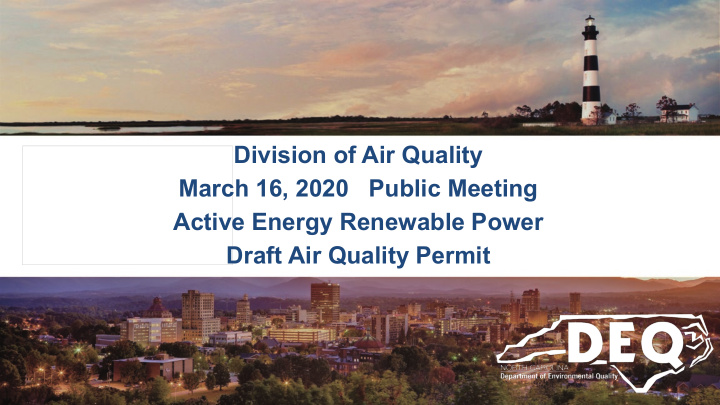



Division of Air Quality March 16, 2020 Public Meeting Active Energy Renewable Power Draft Air Quality Permit
Public Meeting Objectives Active Energy Renewable Power (AERP) – Draft Air Quality Permit • Explain permitting process • Describe permit classification • Share expected facility emissions compared with actual county-wide emissions • Describe the equipment being permitted • Summarize permit requirements • Open floor for comments and questions about the draft permit • Responses to questions/comments will be captured in the permit review 2
Permitting Process • Permit application receipt & review • Verify emission factors and process rates • Determine permit classification – Small, Synthetic Minor, Title V • Determine applicable rules/regulations – federal & state • Write enforceable permit requirements for applicable rules • Issue the permit 3
Compliance Program DAQ issued permits require a combination of (if not all of) the following: • Inspection & Maintenance program • Monitoring and Recordkeeping • Reporting • Source Testing DAQ conducts unannounced inspections to verify compliance 4
Active Energy Renewable Power 5 5
Application Receipt and Permit Classification • Permit Application was received on November 4, 2019 • Review of emission rates/factors shows AERP has the potential to emit: <100 tons/yr of Criteria Air Pollutants and <25 tons/yr of Hazardous Air Pollutants • An Air Quality Permit is required for AERP and they will be classified as a small or minor source 6
Process Equipment Emission Emission Source Control Control System Source ID Description System ID Description ES-B-1 Natural Gas-Fired Boiler N/A N/A (NSPS) 20 mmBtu/hr maximum heat input Water Circulation ES-P-1 Pressure Cooker Process CD-1 Condenser Screw Press/Pellet Press/Natural Gas- ES-SPD-1 fired Dryer Process N/A N/A 4 mmBtu/hr maximum heat input 7
Other Equipment Wastewater Treatment Plant 180 HP Diesel-fired Fire Pump (NESHAP ZZZZ) (NSPS IIII) 15 HP Diesel-fired Emergency Generator (NESHAP ZZZZ) (NSPS IIII) Propane Vaporizer Pellet Storage 8
Process Description wet cellulosic material from pressure cooked using green & dry pressure cooker sent to a steam generated from wood chips are Screw Press, de-watering 20 mmBtu/hr natural raw material gas-fired boiler water vapor & VOCs condensed in a water-cooled de-watered cellulosic condenser material sent to pellet press pellets conveyed to finished pellets to 4 mmBtu/hr pellet storage bin natural gas-fired dryer 9
Small Source Permit Requirements Applicable Federal Rules (combustion): • NSPS Dc (boiler) • NSPS IIII & NESHAP ZZZZ (engines) State Rule Requirements: • 15A NCAC 02Q .0309 - Notification of Start-up • 15A NCAC 02D .0605 - VOC testing within 180 days of start-up (ES-P-1 & ES-SPD-1) • 15A NCAC 02D .0611 - Condenser - continuous temperature monitoring, recordkeeping, and I&M 10
Other Applicable Rules • 15A NCAC 2D .0503 Particulates from Fuel Burning Indirect Heat Exchangers • 15A NCAC 2D .0515 Particulates from Miscellaneous Industrial Processes • 15A NCAC 2D .0516 Sulfur Dioxide Emissions from Combustion Sources • 15A NCAC 2D .0521 Control of Visible Emissions • 15A NCAC 2D .0535 Excess Emissions Reporting and Malfunctions • 15A NCAC 2D .0540 Particulates from Fugitive Dust Emission Sources • 15A NCAC 2D .1806 Control and Prohibition of Odorous Emissions • 15A NCAC 2Q .0711 Emission Rates Requiring a Permit 11
What air emissions are expected? AERP Expected Robeson County Pollutant Actual Air Emissions Total Air Emissions (tons per year) CY 2016 (tons per year) Fine Particulate Matter PM 2.5 0.05 656 Sulfur Dioxide (SO 2 ) 0.05 86 Carbon Monoxide 7.91 18,437 Volatile Organic Compounds 23.63 4,139 Nitrogen Oxides (NOx) 9.41 3,348 Toxic / Hazardous Air Pollutants 2.48 797 (CY 2014) (acetaldehyde highest) * Eight (8) TAPs identified. All are below the emission rates requiring modeling. 12
Proposed Air Permit Recap of major issues: • Majority of air emissions are VOCs; • No TAPs exceed the rate requiring a permit and modeling; • VOC emissions - compliance verified through stack testing and continuous parameter monitoring. 13
Documents Review and Comment Submittals Draft Permit, Draft Permit Review, Permit Application, Environmental Justice Snapshot and Public Notice: https://deq.nc.gov/news/events/public-meeting-active-energy Public comment period closes March 20th at 5pm: Email to DAQ.publiccomments@ncdenr.gov – please type “Active Energy Renewable Power ” in the subject line. 14
Comments or Questions? Now we will call to the microphone those who have signed up to ask questions or make comments. Heather Carter Greg Reeves Regional Supervisor Permit Coordinator 910-433-3361 910-433-3373 Heather.Carter@ncdenr.gov Gregory.Reeves@ncdenr.gov 15
Recommend
More recommend